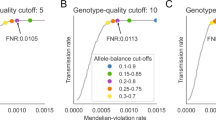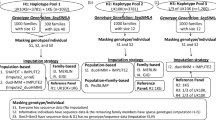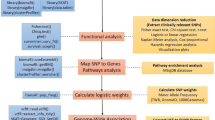Abstract
Quantitative cosegregation analysis can help evaluate the pathogenicity of genetic variants. However, genetics professionals without statistical training often use simple methods, reporting only qualitative findings. We evaluate the potential utility of quantitative cosegregation in the clinical setting by comparing three methods. One thousand pedigrees each were simulated for benign and pathogenic variants in BRCA1 and MLH1 using United States historical demographic data to produce pedigrees similar to those seen in the clinic. These pedigrees were analyzed using two robust methods, full likelihood Bayes factors (FLB) and cosegregation likelihood ratios (CSLR), and a simpler method, counting meioses. Both FLB and CSLR outperform counting meioses when dealing with pathogenic variants, though counting meioses is not far behind. For benign variants, FLB and CSLR greatly outperform as counting meioses is unable to generate evidence for benign variants. Comparing FLB and CSLR, we find that the two methods perform similarly, indicating that quantitative results from either of these methods could be combined in multifactorial calculations. Combining quantitative information will be important as isolated use of cosegregation in single families will yield classification for less than 1% of variants. To encourage wider use of robust cosegregation analysis, we present a website (http://www.analyze.myvariant.org) which implements the CSLR, FLB, and Counting Meioses methods for ATM, BRCA1, BRCA2, CHEK2, MEN1, MLH1, MSH2, MSH6, and PMS2. We also present an R package, CoSeg, which performs the CSLR analysis on any gene with user supplied parameters. Future variant classification guidelines should allow nuanced inclusion of cosegregation evidence against pathogenicity.




Similar content being viewed by others
References
Rosenthal EA, Ranola JO, Shirts BH (2017) Power of pedigree likelihood analysis in extended pedigrees to classify rare variants of uncertain significance in cancer risk genes. Fam Cancer. doi: 10.1007/s10689-017-9989-6
Plon SE et al (2008) Sequence variant classification and reporting: recommendations for improving the interpretation of cancer susceptibility genetic test results. Hum Mutat 29(11):1282–1291
Thompson D, Easton DF, Goldgar DE (2003) A full-likelihood method for the evaluation of causality of sequence variants from family data. Am J Hum Genet 73(3):652–655
Felix GE et al (2014) Germline mutations in BRCA1, BRCA2, CHEK2 and TP53 in patients at high-risk for HBOC: characterizing a Northeast Brazilian Population. Hum Genome Var 1:14012
De Nicolo A et al (2009) Multimodal assessment of protein functional deficiency supports pathogenicity of BRCA1 p.V1688del. Cancer Res 69(17):7030–7037
Tischkowitz M et al (2008) Pathogenicity of the BRCA1 missense variant M1775K is determined by the disruption of the BRCT phosphopeptide-binding pocket: a multi-modal approach. Eur J Hum Genet 16(7):820–832
Johnston JJ et al (2012) Secondary variants in individuals undergoing exome sequencing: screening of 572 individuals identifies high-penetrance mutations in cancer-susceptibility genes. Am J Hum Genet 91(1):97–108
Arnold S et al (2009) Classifying MLH1 and MSH2 variants using bioinformatic prediction, splicing assays, segregation, and tumor characteristics. Hum Mutat 30(5):757–770
Jarvik GP, Browning BL (2016) Consideration of cosegregation in the pathogenicity classification of genomic variants. Am J Hum Genet 98(6):1077–1081
Richards S et al (2015) Standards and guidelines for the interpretation of sequence variants: a joint consensus recommendation of the American College of Medical Genetics and Genomics and the Association for Molecular Pathology. Genet Med 17(5):405–424
Mohammadi L et al (2009) A simple method for co-segregation analysis to evaluate the pathogenicity of unclassified variants; BRCA1 and BRCA2 as an example. BMC Cancer 9:211
Ranola JO, Shirts BH (2016) CoSeg R package. Available from: https://r-forge.r-project.org/projects/coseg/. Accessed 6 July 2017
Ranola JO, Shirts BH (2017) Analyze my variant website. Available from: http://www.analyze.myvariant.org/. Accessed 6 July 2017
United Nations, Department of Economic and Social Affairs. Population Division (1994) World population prospects: the 1998 revision. Volume I: comprehensive. United Nations,New York, p 627
United Nations, Department of Economic and Social Affairs. Population Division (1999) World population prospects: the 1998 revision. Volume II: sex and age. United Nations, New York, p.883
Bell FC, Wade AH, Goss SC (1992) Life tables for the United States, Social Security area: 1900–2080. Actuarial study. U.S. Social Security Administration, Office of the Actuary, Baltimore, p 106
Shirts BH et al (2016) Improving performance of multigene panels for genomic analysis of cancer predisposition. Genet Med 18(10):974–981
van der Kolk DM et al (2010) Penetrance of breast cancer, ovarian cancer and contralateral breast cancer in BRCA1 and BRCA2 families: high cancer incidence at older age. Breast Cancer Res Treat 124(3):643–651
Quehenberger F, Vasen HF, van Houwelingen HC (2005) Risk of colorectal and endometrial cancer for carriers of mutations of the hMLH1 and hMSH2 gene: correction for ascertainment. J Med Genet 42(6):491–496
Wei EK et al (2009) Cumulative risk of colon cancer up to age 70 years by risk factor status using data from the Nurses’ Health Study. Am J Epidemiol 170(7):863–872
Cottingham RW, Idury RM, Schäffer AA (1993) Faster sequential genetic linkage computations. Am J Hum Genet 53(1):252–263
Schäffer AA et al (1994) Avoiding recomputation in linkage analysis. Hum Hered 44(4):225–237
Lathrop GM, Lalouel JM (1984) Easy calculations of lod scores and genetic risks on small computers. Am J Hum Genet 36(2):460–465
Lathrop GM et al (1984) Strategies for multilocus linkage analysis in humans. Proc Natl Acad Sci USA 81(11):3443–3446
Mohammadi L et al (2016) CSLR Website. Available from: https://www.msbi.nl/cosegregation/default.aspx. Accessed 6 July 2017
Eggington JM et al (2014) A comprehensive laboratory-based program for classification of variants of uncertain significance in hereditary cancer genes. Clin Genet 86(3):229–237
Murray ML et al (2011) Follow-up of carriers of BRCA1 and BRCA2 variants of unknown significance: variant reclassification and surgical decisions. Genet Med 13(12):998–1005
de la Hoya M et al (2016) Combined genetic and splicing analysis of BRCA1 c.[594-2A > C; 641A > G] highlights the relevance of naturally occurring in-frame transcripts for developing disease gene variant classification algorithms. Hum Mol Genet 25(11):2256–2268
Tricarico R et al (2017) Assessment of the InSiGHT interpretation criteria for the clinical classification of 24 MLH1 and MSH2 gene variants. Hum Mutat 38(1):64–77
Thompson BA et al (2013) A multifactorial likelihood model for MMR gene variant classification incorporating probabilities based on sequence bioinformatics and tumor characteristics: a report from the Colon Cancer Family Registry. Hum Mutat 34(1):200–209
Whiley PJ et al (2011) Splicing and multifactorial analysis of intronic BRCA1 and BRCA2 sequence variants identifies clinically significant splicing aberrations up to 12 nucleotides from the intron/exon boundary. Hum Mutat 32(6):678–687
Bayrak-Toydemir P et al (2008) Likelihood ratios to assess genetic evidence for clinical significance of uncertain variants: hereditary hemorrhagic telangiectasia as a model. Exp Mol Pathol 85(1):45–49
Bland JM, Altman DG (1999) Measuring agreement in method comparison studies. Stat Methods Med Res 8(2):135–160
Aknowledgements
This study was supported by the Damon Runyon Cancer Research Foundation (DRR-33-15), the National Human Genome Research Institute (R21HG008513), and the Fred Hutch/University of Washington Cancer Consortium (NCI 5P30 CA015704-39).
Author information
Authors and Affiliations
Corresponding author
Electronic supplementary material
Below is the link to the electronic supplementary material.
Rights and permissions
About this article
Cite this article
Rañola, J.M.O., Liu, Q., Rosenthal, E.A. et al. A comparison of cosegregation analysis methods for the clinical setting. Familial Cancer 17, 295–302 (2018). https://doi.org/10.1007/s10689-017-0017-7
Published:
Issue Date:
DOI: https://doi.org/10.1007/s10689-017-0017-7




